How To Install Flexible Stainless Radiator Hose
Last Updated on Oct 12, 2022
Radiator hoses convey engine coolant to and from the radiator. The upper hose carries hot coolant from the engine to the radiator. The lower hose carries the cooled fluid back to the water pump and then back into the engine. The water pump circulates this coolant continuously while the engine is running.
Need immediate help for your auto problem? Chat online with an expert:
These hoses are designed to remain flexible across a temperature range from almost -30 degrees to 250 degrees F. For racing applications, loftier performance hoses tin can provide an fifty-fifty wider temperature capability.
Hose construction typically includes a layer of aramid, polyester or Nomex fibers to assist the hose endure pressure. Hoses on today'southward cars can last well over 100,000 miles, sometimes indelible to twice that value.
Hoses, both upper and lower, may contain an internal ringlet bound to help minimize risk of hose collapse. Withal, a radiator hose collapse tin occur under certain conditions and left unchecked, it can crusade astringent engine impairment. Fortunately, the fix is usually both cheap and easy.
What is a "Complanate" Radiator Hose?
A collapsed radiator hose looks similar a long skinny flat tire. Very noticeable. One or both hoses may go flat if the cooling system experiences a localized or consummate vacuum (negative pressure) status.
Why has My Radiator Hose Complanate?
There are 2 possible reasons for a collapsed radiator hose:
- Reason 1 – A vacuum within the coolant system volition cause one or both radiator hoses to collapse. This negative pressure volition occur when the engine has been close off and the normal return menses of coolant from the expansion tank is blocked. This vacuum trouble may be caused by #ane and #2 below.
- Reason 2 – Restricted flow through the radiator (a chock-full radiator) tin crusade the lower radiator hose to collapse. See cause #3 below.
#1 – Faulty Radiator Cap
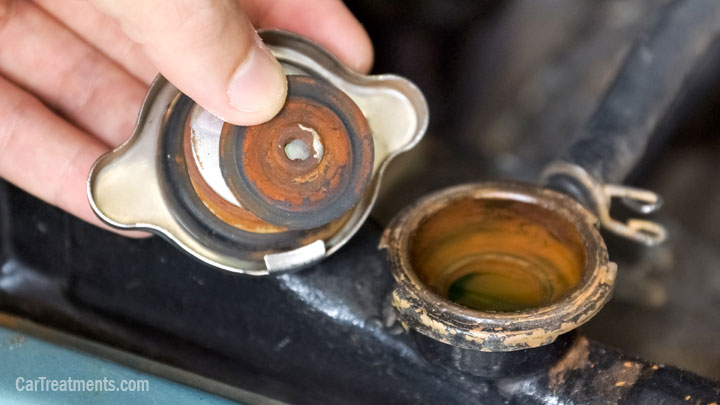
The commencement and nigh common crusade of a collapsed radiator hose is an inoperative 1 way valve in the radiator cap. This can occur due to historic period or due to contamination of the radiator cap by deposits. Follow these steps if you find a collapsed hose, either top and/or bottom.
Caution
Never attempt to remove the cap when the engine is hot.
- With a cool engine, remove the radiator cap.
- If upon removing the cap the hose (or hoses) quickly return to normal size the problem is either the radiator cap or a blocked vent hose.
- Examine the cap. If information technology is coated with viscid deposits it may be possible to clean it. Using dishwashing detergent and a soft toothbrush, clean abroad all deposits. Rinse the cap thoroughly. Wipe any deposits from the mating surfaces on the radiator (or expansion tank) with a clean shop towel.
- Reinstall the cap.
- Start the auto, warm the engine, and permit it to run until antifreeze flows into the expansion tank. A short drive can speed up this process. Shut off the engine and after it cools down confirm that the hose(s) no longer are collapsing.
- If hose collapsing still occurs, replacement of the defective cap may be required. New cap prices range from nigh $8 to $25 at your local or online car parts store.
Using Dex-Cool Antifreeze or Cease Leak?
Both Dex-Cool and Stop Leak deposits accept a tendency to build upward in the radiator cap mechanism. If with a collapsed hose you remove the radiator cap (when the engine is cool), and information technology is gummed up, one or both of these products may be the cause. Either follow the cleaning steps to a higher place or replace the cap.
When using Dex-Cool or Stop Leak, checking the radiator cap for deposits at each oil change and cleaning it as necessary is recommended.
#2 – Blocked Expansion Tank Hose
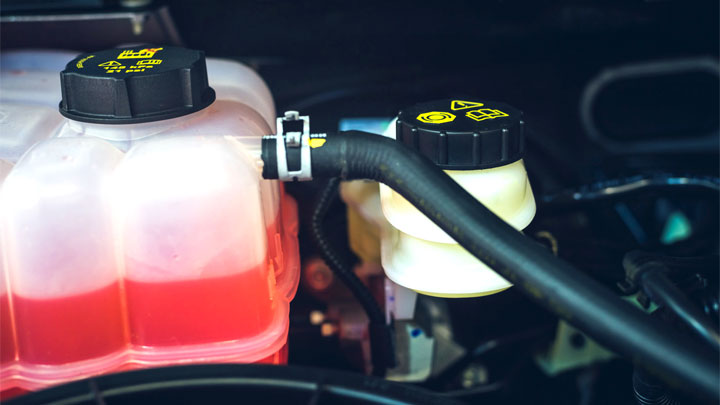
While a blocked vent hose is a relatively uncommon effect, if it happens, it tin can prevent air flow dorsum into the expansion tank as the engine cools. This will mimic the problem that occurs with a gummed up radiator cap.
Every bit with a faulty radiator cap, follow these steps:
- Later on assuasive the engine to cool down, remove the radiator cap.
- Notice the complanate hose(due south). They should return to normal size.
- Examine the cap. If it is gratuitous of deposits, the trouble is probable to be a blocked vent hose.
- To check for a blocked hose, detach the vent hose from the fitting on the expansion tank. Practice this advisedly because expansion tanks are generally plastic, and you don't desire to break this hose fitting.
- Insert a clean plastic drinking straw into the end of this hose. (A stiff plastic reusable child'south straw volition work all-time.) Blow through this straw. Any restriction will exist evident.
- Mostly, the vent hose will be routed down through several clamps and end below the engine. Remove this hose from its retaining clamps and using your garden hose, thoroughly rinse out any particulate affair that may be the cause of blockage. A length of potent wire can exist helpful to probe the hose if a blockage is persistent.
- Reinstall the hose through its retaining clamps and reconnect it to the plumbing equipment on the expansion tank.
- Perform the engine warm up/cool down process described in step 5 of the "#1 – Faulty Radiator Cap" cause above. If the coolant hoses no longer collapse during this test, you accept corrected the problem.
See Also: How a Coolant Overflow Tank Works
#3 – Chock-full Radiator (Lower Hose Collapse)
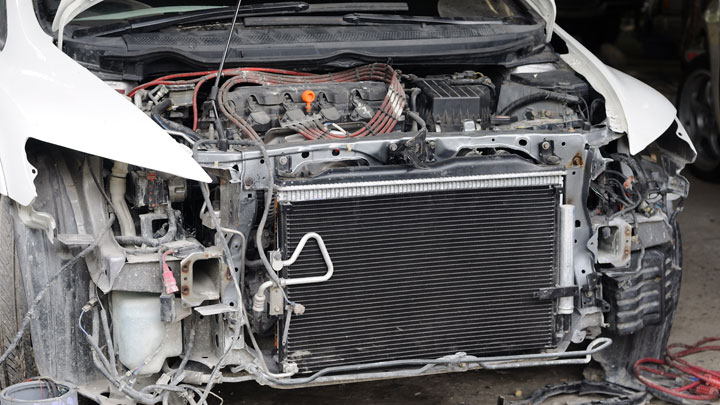
Restricted flow through the radiator tin can result in the collapse of the lower radiator hose. This condition would be noticed while driving.
Your start alarm will be a ascent temperature beyond normal on your engine temperature approximate. Alternatively, a warning light indicating overheating may come on.
When symptoms of engine overheating occur, follow these steps to assess the possibility of a collapsed lower hose:
- Terminate the car, identify the manual in Park (automatic manual) or Neutral (manual manual) and firmly set the emergency brake. Permit the engine to idle.
- Open the hood and observe the lower hose. Exist conscientious to keep your easily out of that area.
- If the hose appears to be normal in size, have an associate gently printing the gas pedal to gradually increase the engine speed. Equally the water pump speed increases with restricted flow through the radiator, the hose collapses on acceleration.
- If the hose collapses, you've discovered a problem that will need immediate attention. Follow these next steps:
- Allow the engine to go along to run at idle or slightly above idle but not fast enough to flatten the lower hose. Engine temperature should gradually return to normal.
- Once it has cooled, proceed slowly to your favorite repair shop for corrective action. If overheating reoccurs, you may have to call for a tow.
Read Also: How to Flush Your Radiator
Checking Your Radiator Hoses
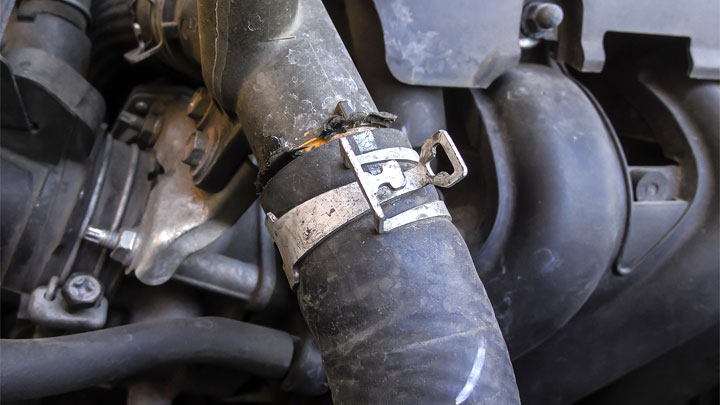
At every oil change, you lot should evaluate the condition of your radiator hoses. The engine must be turned off and absurd to do this. Never use your easily to check the hoses with the engine running as this poses run a risk of severe injury.
Should I be Able to Clasp the Radiator Hoses?
Yeah, with the engine off and cooled down, the hoses should be soft enough to clasp. Hoses in good condition should be flexible to finger pressure just not squishy or spongy feeling. Aging hoses will exist hard and brittle.
Both hoses should exist of uniform diameter with no noticeable bulges or cracks. Squishy, brittle, bulging or croaky hoses are candidates for immediate replacement.
Warning
Erstwhile hoses displaying the age symptoms noted above tin spontaneously rupture. Should you be examining a hot engine even with the engine off, and hose failure occurs you could be severely burned and/or blinded by the spraying coolant.
Should Both Radiator Hoses be Hot?
After a drive of as lilliputian as five miles, the upper hose volition be quite hot every bit information technology will be conveying coolant directly from the engine. If the radiator is doing its task, the bottom hose will be warm to the touch as information technology's conveying cooler fluid back to the engine.
Simply if the lower hose is common cold to the touch after the engine has warmed upwardly, yous likely have a problem.
Can a Collapsed Radiator Hose Cause Overheating?
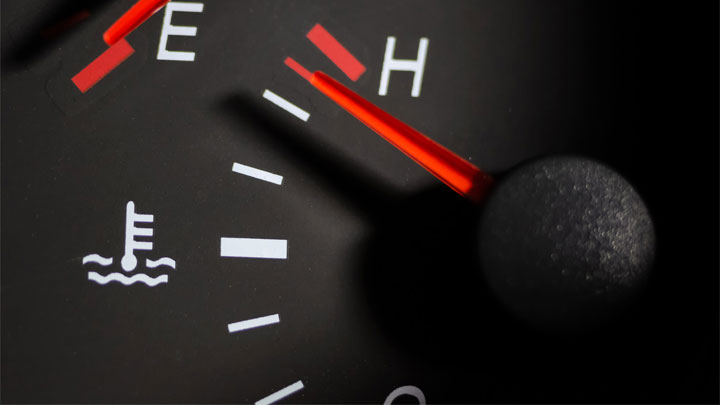
Yes, a collapsed hose tin can cause overheating. If you are driving when a hose goes flat, coolant flow will be restricted. Your instrument console volition give you an elevated temperature indication and/or an overheating warning light.
You must pull to the side of the route and shut off the engine as chop-chop equally possible. Continuing to bulldoze with an overheated condition can crusade severe engine damage.
It's worth noting that engine overheating problems may derive from several other causes besides a collapsed hose.
What is the Function of the Radiator Cap?
The radiator cap closes your cooling organisation only enables coolant to flow to and from the expansion tank (radiator coolant overflow tank).
Further information regarding how the radiator cap works and related potential problems can be institute hither: 6 Symptoms of a Bad Radiator Cap (and When to Replace)
Radiator Hose Replacement Cost
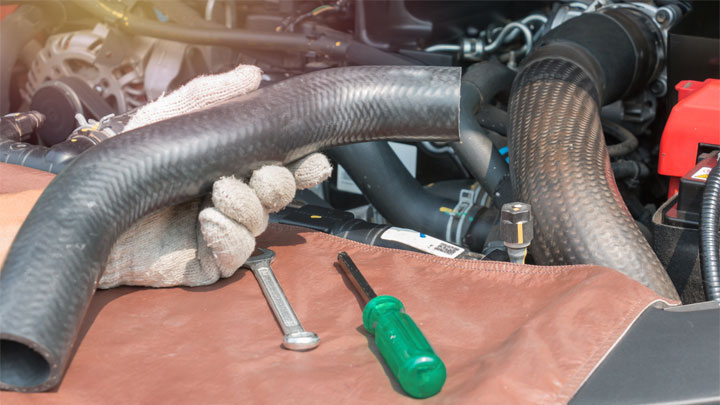
The cost to supersede both upper and lower radiator hoses at your car repair store can range from $eighty to over $500. This toll volition depend on the make and model of your car. Replacement costs at your dealer may run slightly higher.
Source: https://cartreatments.com/radiator-hose-collapse/
Posted by: allmanwhispectilly.blogspot.com


0 Response to "How To Install Flexible Stainless Radiator Hose"
Post a Comment